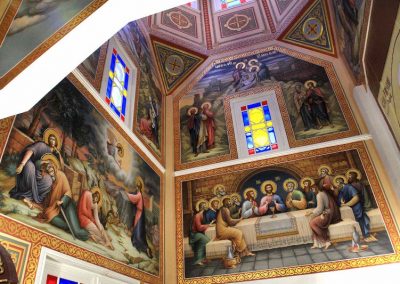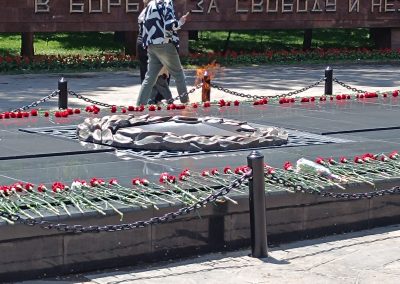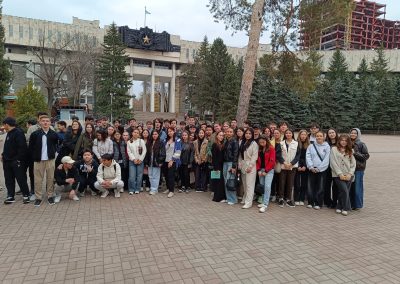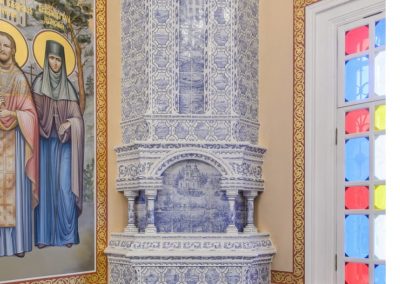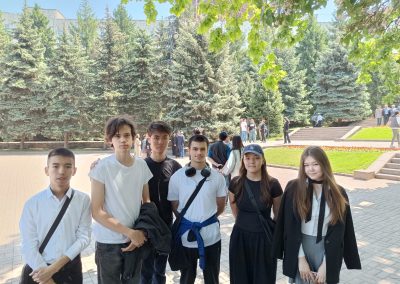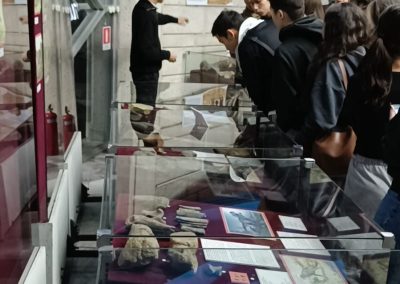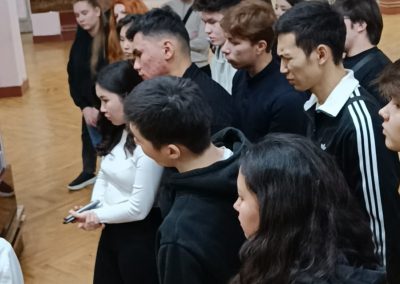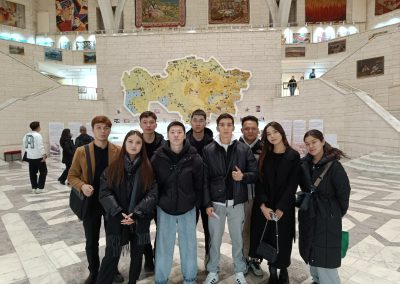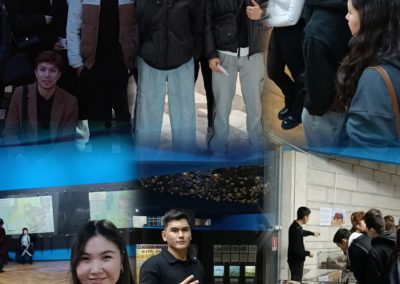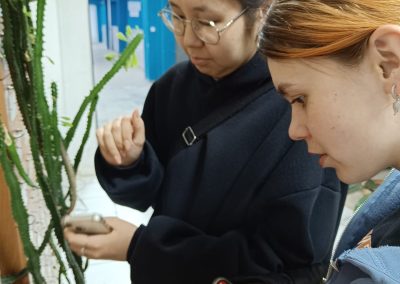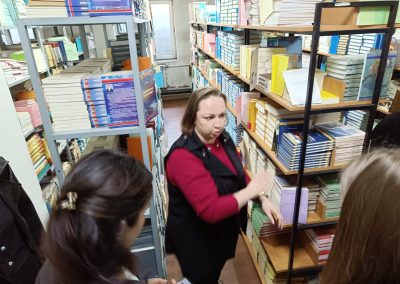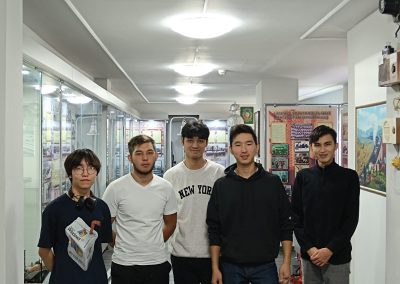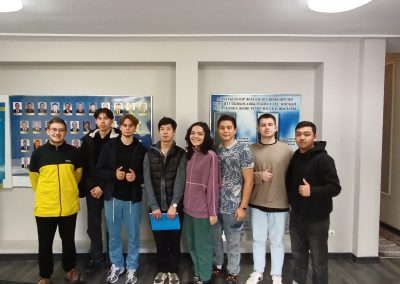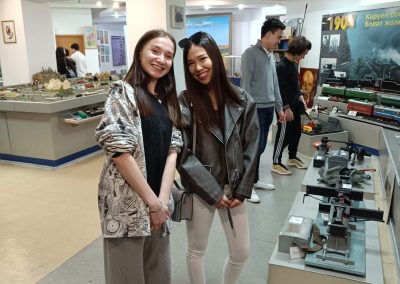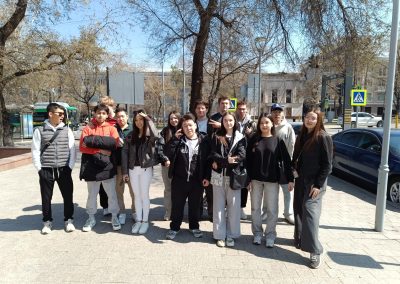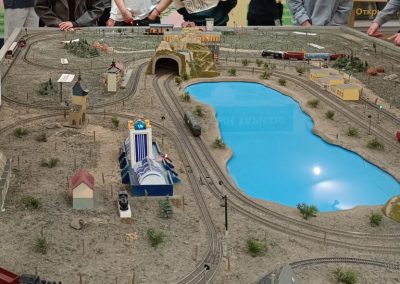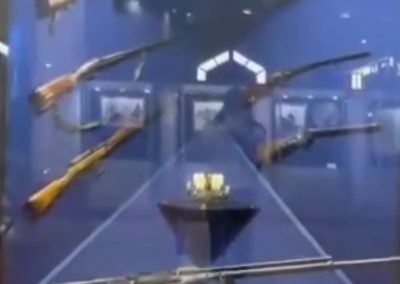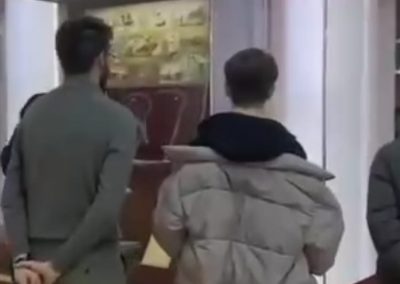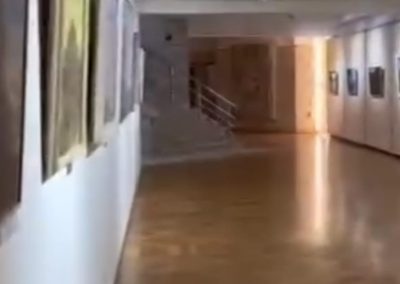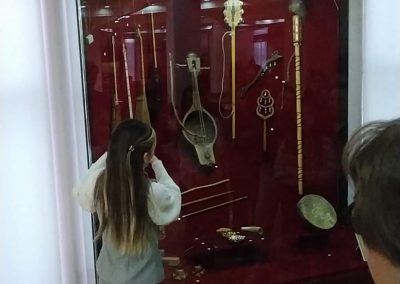Miras Circle

Director
Aitkazina Mira Mukhtarovna associate professor
tel. 87077231074,
e-mail: m.аytkazina@alt.edu.kz
Name of the circle: “Miras” has been operating since 2017.
Regulations of the STUDENT GROUP «MIRAS»
1. General provisions
1.1 Circle «Miras» is formed on the basis of Kazakh Academy of Transport and Communication named after M. Tynyshpaev (now ALT University named after M. Tynyshpaev). M. Tynyshpayev Kazakh Academy of Transport and Communication (now ALT University named after M. Tynyshpayev), ‘SHD&PD’ department.
1.2 The Student Circle is a voluntary organisation of students who have expressed a desire to master the skills of scientific research and successfully combine such activities with their studies, who have a love for their history and culture.
1.3 The Student Circle meets once a month. The chairman informs the SC members about the dates and time of the meetings.
1.4 To carry out the organisational work and record the activities of the Student Circle, the Chairperson of the Circle is elected from among the students (for a period of one year). If there are more than 15 students in the Circle, a secretary of the Circle may be elected to assist the chairman in filling in the minutes.
2. Purpose and objectives of the student circle «Miras»:
2.1 Development of creative thinking, scientific independence, increase of internal organisation, conscious attitude to study, deepening and consolidation of knowledge obtained in the process of study.
2.2 The main objectives of the circle:
- Formation of active life position of students;
- excursion to historical places;
- study of biographies of famous people;
- spiritual education on the basis of popularisation of cultural and historical values of the Kazakh people;
- traditions and customs of the national history of our land.
3. The right of the members of the student circle «Miras»:
3.1. To have the right to elect a candidate of the chairman of the circle and to propose it for approval at the meeting of the circle;
3.2. To have the right to nominate the leaders of the circle;
3.3. To make scientific reports and papers at the meetings of the Circle and scientific conferences.
3.4. Have the right to protect the motto and emblem of the Circle.
4. Duties of the members of the student circle «Miras»:
4.1 Participation in the work of the meeting of the circle, once a month in which, the results of scientific work of the members of the circle (scientific articles, abstracts and competitive works) are discussed.
4.2. Filling in and timely registration of events;
4.3. summarising the results of the Circle’s work. Plans of the Circle’s activities are kept during the whole academic year.
5. List of documents:
5.1. Regulations.
5.2. Curriculum and thematic plan.
5.3. Enrolment list;
5.4. Structure of the circle;
5.5. Protocols.
6. Plans of the circle
6.1 Participation and fulfilment of planned scientific works.
6.2 Development of reports and presentations at SC and seminars;
6.3. Development of reports and performance with them on SH and seminars.
6.4. Excursions and excursion to the city of Almaty and its suburbs.
Programme of the student circle «Miras»
Commentary
The programme of the circle «Miras» is directed to expand students’ knowledge about their native land, to see it in the general course of history, to feel their connection with the past and present of the country, to bring up the feeling of pride for their fellow countrymen, to promote the development of: spiritual memory, the feeling of kinship, respect for those who live nearby. By collecting information about their fellow countrymen, students preserve the history of their homeland for the future generation. In addition, museum and local history material, as closer and more familiar, enhances the concreteness and clarity of students’ perception of the historical process and has an educational effect. This programme is designed to help the teacher to create conditions for the development of information and communication competences of students in the extracurricular time.
The main directions in the activity of the circle are the study of the history of the native land, design and replenishment of the expositions of the universities museum.
The circle is organised among students of all courses.
The main directions of the programme:
- Formation of a sense of moral and patriotic consciousness among students;
- studying the rich ethno-culture and local history of our republic;
- motivate students to self-realisation through the activities of the circle;
- to increase the spiritual culture and awareness of students.
The aim of the programme:
- To form a cognitive need to master historical material;
- to broaden and deepen students’ knowledge of their native land with the help of search and local history work;
- to form skills of communication, preparation of events, design of research works;
- to bring up patriotism.
How to implement the programme:
- to create slides on search work about the peculiarities of the native land;
- learn to use sources of information: periodicals, scientific magazines, videos, discs, Internet, television;
- to learn how to make a report in front of their classmates.
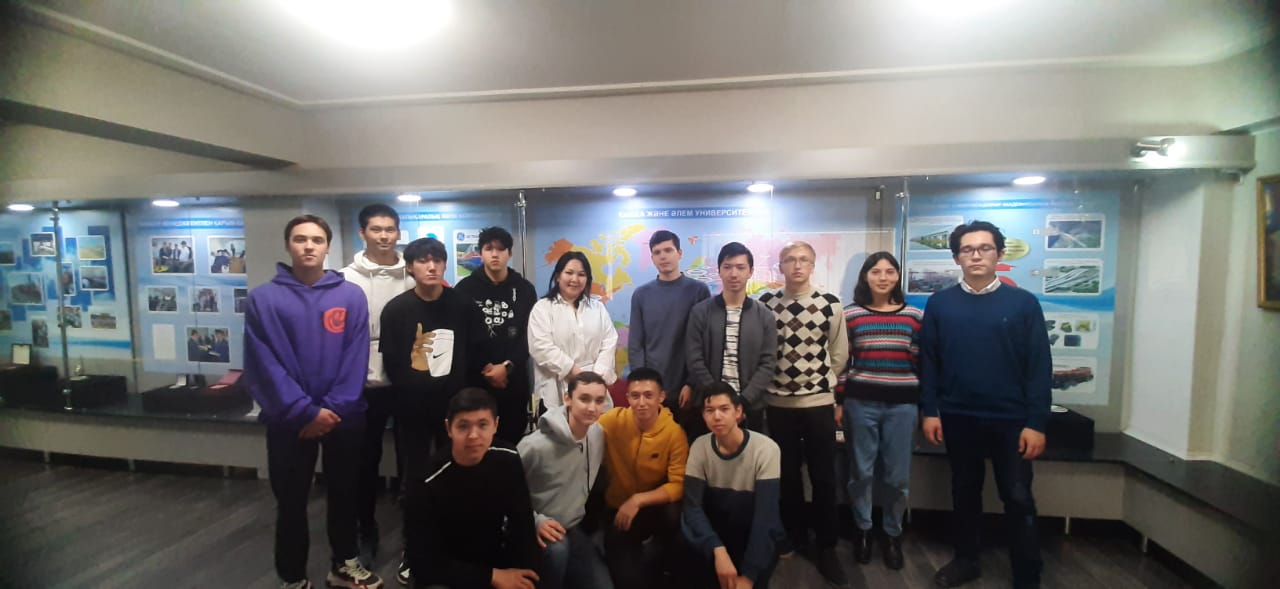
Walk of Fame, Ascension Cathedral – May 2025.
The park was founded during the construction of Verny on the site of the village cemetery (in 1921 the cemetery was destroyed by a mudflow). The graves of the Kolpakovsky family, daughter Leonilla Kolpakovsky (burial in 1860) and grandson Vladimir Bazilevsky (1882; tombstone restored in 2011) have been preserved. The mass grave in memory of the victims of the earthquake of 28 May 1887 is also lost. The Old Cemetery Park was later joined with the Cathedral Park and was named City Garden. In 1885, pavilions and pavilions, a buffet where ice-cream, fruit and tea were sold were arranged in the park. Drinking alcoholic beverages in the park was forbidden. It was also forbidden to ride horses in the park.
- M. Zenkov took part in the regular lay-out of the garden.
The name of the park was regularly changed: in 1899, in connection with the 100th anniversary of the birth of A. S. Pushkin, the park was named «Pushkin Garden», in 1919 – Park of Fallen Freedom Fighters, in connection with the burial here of A. Berezovsky and K. Ovcharov and other heroes of the Soviet Semirechye, then it was called ‘local park named after Lenin’, with the banning of the city burial place in 1919. Ovcharov and other heroes of Soviet Semirechye, then it was called ‘local park named after Lenin’, with the prohibition of urban burials, in the years before 1927 it was called differently: «the garden of Gubkompompomarma» (1925), «Public Park 1 May». In 1927, during the transformation of Alma-Ata into the capital of Soviet Kazakhstan, the park was named ‘Federation of Soviet Republics’ park. In 1942, the park was named in honour of 28 Panfilov Guardsmen in memory of the feat committed during the Great Patriotic War during the defence of Moscow by the soldiers of the 1075th Regiment of the 316th Rifle Division.
The obelisks with the names of 28 Panfilov heroes who survived the battle against the Germans‘ vastly superior forces are a place to honour the heroes’ heroic deeds. The alley adjoins the Memorial Complex of Military Glory and the Eternal Flame, where on Victory Day and other days Almaty residents and guests bring flowers to honour and mourn those who died in the Great Patriotic War of 1941-1945.
Parallel visit to the Ascension Cathedral at the request of students.
The Central State Museum of the Republic of Kazakhstan is one of the oldest and largest museums not only in Kazakhstan, but also the entire Central Asian region. The collections of the museum include about 300 thousand objects. Currently, the museum has seven main stationary halls. Diverse collection provides a good picture of the paleontological past, of the ancient, medieval, modern and contemporary history and cultural tradition of Kazakhstan.
The creation of museum collections was initiated in the 30s of the 19th century in Orenburg, at Neplyuev Military School “Museum of the Orenburg region”. One of the organizers was a famous linguist, author of “Explanatory Dictionary” Vladimir Dal.
In different years the museum collection composed not only the museum collection of the Orenburg region (1924), but also the Zhetysu (Semirechye) Regional Museum (1929) and the National anti-religious museum (1941) which was placed in the building of the Voznesenski Cathedral in Alma-Ata city. This unique architectural complex was built in 1904-1907 and designed by the well-knownVerny architect A.P.Zenkov.
In 1944 the museum was assigned to the 1st category and received its present name – the Central State Museum of Kazakhstan.
This building was constructed by architects Yu.Ratushnyi, Z.Mustafin and B.Rzagaliyev in 1985. It is considered one of the finest buildings of modern architecture of the Almaty city.
The University Museum was created to preserve the history of the University development, to form the national pride of the students and staff of the University, to cherish the history and culture, to strengthen the relationship between educational institutions.
The main objectives of the museum are:
- Promoting the education of students, staff and party visitors. Studying, comprehending and preserving the history and culture of the university development in order to develop intellectual, moral, cultural and creative abilities of students, to foster their national pride, to introduce them to the national and universal culture, to preserve corporate university traditions and rituals, patriotic and ideological education.
- Carrying out cultural, educational and ideological-patriotic work among students, parents, staff and visitors.
- Popularisation of museum collections.
- Carrying out cultural, educational and ideological-patriotic events.
- Opening, filling and maintenance of the museum section on the university website.
- Organisation of meetings of students and employees of the university with veterans of the university, alumni with the purpose of popularisation of education and preservation of traditions and history of the university.
The ALT Museum presents exhibits from the family collections of M. Tynyshpayev, veterans and employees of the University.
Library – the history begins with the moment of opening of Almaty Institute of Engineering Transport in 1976 (ALT).
Now BIC is a structural subdivision of ALT University named after Mukhametzhan Tynyshpayev, providing library and information-bibliographic services, ensuring educational and scientific activities. The ALT fund has a unique collection of literature on the development of the railway since 1925. The best classical editions of the past years on road construction and transport technology. Along with the electronic catalogue there is a paper catalogue system. During the excursion the students got acquainted with its work.
The museum consists of several thematic halls telling about certain stages of formation and development of the Kazakhstan railway and Turksib (documents, maps, awards).
The Almaty Railway Museum is one of the largest technical museums in Kazakhstan. The history of the museum began in 1999, when a small departmental museum was organised on the basis of the personal collection of Beisen Shormakov, an honorary railwayman and veteran of railway transport.
Familiarity with the exposition of the museum begins with the hall of the carriage transport that passed through the route of the Silk Road.
Among the unique exhibits, one can refer to the authentic map of ‘Railway, postal and steamship communications of the Russian Empire’ in 1894. The first railway section on the territory of Kazakhstan – from Pokrovskaya Sloboda to the city of Uralsk – is separately marked on it. Its construction began in 1892.
A separate stand tells about the construction of the Trans-Kazakhstan railway Orenburg-Tashkent. The history of Kazakhstani railways began with the completion of the Orenburg-Kazalinsk section in 1904. The first locomotive depot on the territory of Kazakhstan appeared in Kazalinsk.
A significant part of the exposition is dedicated to the legendary Turksib. Built between 1927 and 1931, the Turkestan-Siberian railway became one of the most ambitious projects of the young Soviet state. The construction of the Turksib was simultaneously carried out from Lugovoy station to Aina-Bulak on one side and from Semipalatinsk on the other. The collection of the museum presents tools of workers who built the Turksib: picks, shovels, oil lamps, presses for soil compaction, huge saws for cutting sleepers.
Collection of scale models – there are dozens of models of locomotives made in the smallest detail. They demonstrate the full evolution of the technology – from the first steam locomotives to modern superfast trains. Large scale models of locomotives from 1905 to the present day are presented separately.
In the centre of the hall is a large scale model of a working mechanical railway with precise details of bridges, stations, junctions, steam locomotives, carriages, simophores, which aroused great interest among the students.
CENTRAL STATE MUSEUM OF THE REPUBLIC OF KAZAKHSTAN
Field trip with first-year students of all specialties to one of the oldest and largest museums not only in Kazakhstan, but also in the entire Central Asian region. The museum’s collections contain about 300,000 items. Currently, the museum has seven main permanent exhibition halls, whose diverse collections provide a vivid picture not only of the paleontological past, but also of the ancient, medieval, modern and contemporary history and cultural heritage of Kazakhstan.




